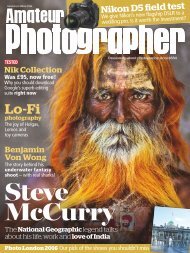You also want an ePaper? Increase the reach of your titles
YUMPU automatically turns print PDFs into web optimized ePapers that Google loves.
ASTROCONFIDENTIAL ASTRONEWS<br />
BY<br />
ERIC BETZ<br />
FIVE QUESTIONS WITH JOE TAYLOR<br />
LIGO rocked the scientific world by detecting gravitational<br />
waves — a phenomenon chased by astronomers<br />
since the 1960s. However, LIGO isn’t the first<br />
real-world evidence for gravitational waves.<br />
Astronomer Joseph Taylor claimed that prize<br />
back in 1978, when he showed a pair of pulsars —<br />
rapidly spinning neutron stars — was spiraling in<br />
toward each other, emitting gravitational radiation.<br />
These pulsars are dense stellar corpses with masses<br />
larger than the Sun, packed into a sphere the size of<br />
New York City.<br />
That find earned Taylor a ticket to Stockholm with<br />
his former graduate student Russell Hulse. The pair<br />
won the 1993 Nobel Prize in physics. Their binary<br />
pulsar, designated PSR B1913+16, was a crucial test of<br />
general relativity because its tightening orbit allowed<br />
them to measure how much energy was leaking out<br />
in the form of invisible gravitational waves.<br />
THE NOBEL FOUNDATION<br />
Q: Pulsars are now relatively<br />
well-known astrophysical<br />
phenomena, but they were<br />
exotic when you started<br />
your career. Can you take<br />
us back to what it was like<br />
in the late 1960s and ’70s<br />
when pulsars were first<br />
being discovered?<br />
A: The announcement of<br />
the discovery of pulsars in<br />
February 1968 was a big surprise.<br />
It was a major departure<br />
in that the type of signal was<br />
something that varies rapidly.<br />
Radio astronomy was young at<br />
the time anyway, but all of the<br />
known sources were essentially<br />
constant in amplitude.<br />
It’s fair to say that radio<br />
astronomers everywhere<br />
were at first skeptical and<br />
then wanted to do what they<br />
could to follow up on the<br />
original observations made<br />
in Cambridge, England. I had<br />
just passed my final oral<br />
examination as a Ph.D. student,<br />
and I was hired on as a<br />
postdoctoral fellow at Harvard<br />
Observatory with more or less<br />
a blank slate to work on whatever<br />
I wanted to.<br />
Q: Was it immediately<br />
obvious that PSR B1913+16<br />
was a binary pulsar when<br />
you found it in your survey<br />
at the Arecibo Observatory<br />
several years later?<br />
A: Immediately we thought it<br />
must be not be a pulsar at all;<br />
it must be interference because<br />
its period is not constant and<br />
all the rest of them were very<br />
constant. It turned out to be<br />
pretty easy to show it was not<br />
interference because if we<br />
turned the antenna by a little<br />
bit, the signal would go away.<br />
So, it was coming from the<br />
sky and it clearly had many<br />
of the signals of a pulsar, but<br />
it was faster than almost any<br />
pulsar at the time. The only<br />
one faster was the one in the<br />
Crab Nebula, so it was of special<br />
interest for that reason,<br />
but it was of particular interest<br />
because its period changed.<br />
After several weeks, we knew<br />
we had found a pulsar orbiting<br />
another star. It was clear that<br />
you could calculate the velocity;<br />
it was about one-tenth of 1 percent<br />
the speed of light. So, it<br />
was a relativistic system.<br />
Q: What did this pulsar<br />
system ultimately teach us<br />
about relativity?<br />
A: What turned out to be the<br />
most important prediction is<br />
that a system like this should<br />
lose energy gradually in the<br />
form of gravitational waves.<br />
Those waves should be carrying<br />
away orbital energy and<br />
orbital momentum, and the<br />
orbit should gradually evolve.<br />
Q: What was the state of<br />
gravitational wave research<br />
at the time? Had other<br />
attempts like this been done?<br />
A: No. It was a very different<br />
environment at the time. It<br />
wasn’t even by any means an<br />
agreed-upon conclusion that<br />
general relativity necessarily<br />
accommodates gravitational<br />
radiation. Even Einstein had<br />
STELLAR CORPSE. Pulsars rotate so fast that even a “mountain” rising centimeters<br />
from the surface could create gravitational waves that astronomers might soon<br />
be able to detect on Earth. ASTRONOMY: ROEN KELLY<br />
some doubts about that over his<br />
life. There were several papers<br />
published in the teens — 1916,<br />
1918 — describing gravitational<br />
radiation as a part of relativity<br />
theory, but in the 1930s, even<br />
Einstein had doubts.<br />
Q: So, even by the 1970s, it<br />
wasn’t clear that gravitational<br />
waves should exist?<br />
A: I think the weight of<br />
opinion in physics was that<br />
gravitational radiation is a phenomenon<br />
that almost certainly<br />
exists, but that it is going to be<br />
very hard to detect, if ever. Of<br />
course, it’s hard to predict what<br />
technology changes there are<br />
going to be.<br />
But at the level of technology<br />
in the ’50s or ’60s — maybe<br />
even the ’70s — there was no<br />
way to see how that kind of<br />
thing could be detected.<br />
That’s the time when Joseph<br />
Weber started experimentally<br />
putting together an apparatus<br />
that he hoped might enable<br />
him to do this. So, there was<br />
serious interest, but some skepticism<br />
about whether or not it<br />
would be possible.<br />
And there was still some<br />
theoretical skepticism about<br />
whether we correctly understood<br />
what the complicated<br />
non-linear theory of relativity<br />
predicts. There were serious<br />
papers being published questioning<br />
whether gravitational<br />
waves should exist.<br />
Editor’s note: This interview<br />
has been edited for clarity and<br />
space.<br />
WWW.ASTRONOMY.COM 17






